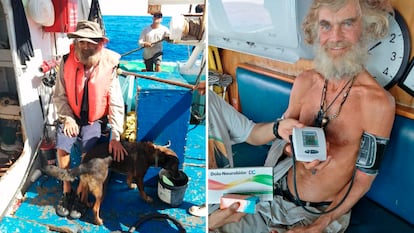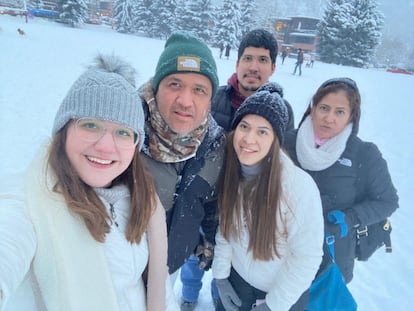Australian castaway Tim Shaddock: ‘I’m just so grateful. I’m alive and I didn’t really think I’d make it’
The 54-year-old sailor was found with his dog in the middle of the Pacific Ocean by a Mexican trawler after surviving on raw fish and rainwater for three months

It has been three months since Tim Shaddock, a 54-year-old Australian sailor, and his dog Bella last set foot on dry land. Shaddock had set sail from La Paz, in Baja California Sur in Mexico, bound for French Polynesia, a journey of more than 6,000 kilometers (3,728 miles). However, a storm damaged his boat. Weeks later, a tuna vessel came across the catamaran, adrift in the Pacific Ocean. On Tuesday, after months of eating raw fish and drinking rainwater to survive, Shaddock made landfall again in the port of Manzanillo, in the Mexican state of Colima. “I’m feeling all right. I’m feeling a lot better than I was, I tell ya,” he told the media as he stepped off the boat.
The helicopter belonging to the tuna vessel María Delia, captained by Óscar Meza, spotted Shaddock adrift in a damaged boat in the middle of the Eastern Pacific Ocean, in international waters, more than 2,000 kilometers (1,200 miles) from the coast. “To the captain and fishing company that saved my life, I’m just so grateful. I’m alive and I didn’t really think I’d make it,” he said.
At the time of the rescue, after three months at sea, Shaddock was showing signs of dehydration and sunstroke. Grupomar, the company that owns the tuna trawler, said he and Bella were both in a “precarious” position and had been without adequate provisions or shelter. Crew members provided water, food and medical attention.
The Australian sailor explained his passion for the sea when speaking to reporters after disembarking the María Delia and said he plans to sail again soon. Shaddock had previously traveled on his catamaran, the Aloha Toa, in other parts of the world. “I have been through a very difficult ordeal at sea,” he told Australia’s 9News. “I’m just needing rest and good food because I have been alone at sea a long time. Otherwise, I’m in very good health.” On Tuesday, although dishevelled, Shaddock said he “felt great” as he once again touched dry land. “There were many, many, many bad days and many good days,” he said. “The energy, the fatigue is the hardest part.”
The last time Shaddock saw land was in the Sea of Cortez in the Gulf of California, at the beginning of May, under a full moon.
Grupomar notified the various authorities, from the Ministry of the Navy to the Australian Embassy, of the rescue so that legal protocols could be initiated to allow the shipwrecked Australian to return home to Sydney.
Antonio Suárez, Grupomar’s president, said Tuesday that the voyage during which the María Delia rescued Shaddock may have been its final trip, because he is modernizing the company’s fleet and the boat is its smallest and more than 50 years old. If so, it would be a “marvelous farewell, saving human lives,” Suárez said.
Shaddock hugged Suárez in gratitude, and Suárez invited him to go for a meal in celebration.
When asked what he would like to eat back on land, Shaddock, smiling and jovial as he slid into a waiting car, said “tuna sushi.”
Sign up for our weekly newsletter to get more English-language news coverage from EL PAÍS USA Edition
Tu suscripción se está usando en otro dispositivo
¿Quieres añadir otro usuario a tu suscripción?
Si continúas leyendo en este dispositivo, no se podrá leer en el otro.
FlechaTu suscripción se está usando en otro dispositivo y solo puedes acceder a EL PAÍS desde un dispositivo a la vez.
Si quieres compartir tu cuenta, cambia tu suscripción a la modalidad Premium, así podrás añadir otro usuario. Cada uno accederá con su propia cuenta de email, lo que os permitirá personalizar vuestra experiencia en EL PAÍS.
¿Tienes una suscripción de empresa? Accede aquí para contratar más cuentas.
En el caso de no saber quién está usando tu cuenta, te recomendamos cambiar tu contraseña aquí.
Si decides continuar compartiendo tu cuenta, este mensaje se mostrará en tu dispositivo y en el de la otra persona que está usando tu cuenta de forma indefinida, afectando a tu experiencia de lectura. Puedes consultar aquí los términos y condiciones de la suscripción digital.
More information
Archived In
Últimas noticias
The metaverse, four years later: Is it finished or just at a standstill?
$3,000 and a plane ticket: The United States increases incentives for migrants to self-deport before the end of the year
Charles Dubouloz, mountaineering star, retires at 36 with a farewell tour inspired by Walter Bonatti
From the White House to diplomatic gifts: Lego wins over adult fans, brick by brick
Most viewed
- The low-cost creative revolution: How technology is making art accessible to everyone
- Christian Louboutin: ‘Young people don’t want to be like their parents. And if their parents wear sneakers, they’re going to look for something else’
- All the effects of gentrification in one corner of Mexico’s Colonia Roma
- Christmas loses its festive spirit: ICE fears cast shadow over religious celebrations
- Liset Menéndez de la Prida, neuroscientist: ‘It’s not normal to constantly seek pleasure; it’s important to be bored, to be calm’










































